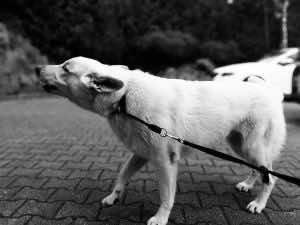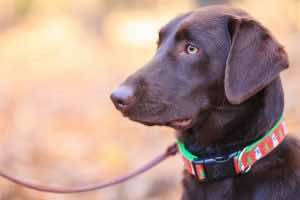 This is one of the top challenge requests I get from clients aside from jumping.
This is one of the top challenge requests I get from clients aside from jumping.
First of all, dogs do what works. I always like to give clients another viewpoint. Potentially from the “dog’s perspective.” In the simplest terms, if dogs don’t want something around and they bark at it, and that thing goes away, it worked! Unfortunately, this also reinforces the behavior, which means it increases the likelihood that that behavior will reoccur.
Now, let’s say it didn’t USED to be that way, or maybe you adopted an older puppy or an adult dog, at some point, a dog barked at them (perhaps a little yappy dog that hasn’t received my card yet ;o)) and your dog barked back! Because that’s how dogs communicate. Whoever had the leash got embarrassed, reigned in the leash, or they got upset simply because “no one wants to have THAT dog in the neighborhood!” So the next walk, the human sees that dog again, or maybe another dog, and even if that dog is across the street and walking calmly (no barking), the human immediately pulls the leash a smidge tighter and holds their breath, WAITING for their dog to react. Here’s the thing, had the human not done those simple non-verbal signals, it’s likely the dog may not have reacted at all because, in his eyes, there wasn’t necessarily something to respond to. But then the dog feels the tension and THINKS there is some reason the human is getting nervous or tense (little does he know it was HIM that was worrying said human), so he barks at the other dog, tension builds! As that tension builds, it, unfortunately, reconfirms the human’s assumption that he will bark at every dog now AND the human moves faster, giving him distance from the object he is barking at, which is a reinforcer for the barking/lunging in this situation. Everyone moves away more quickly, which feels “good” to the dogs, so now that behavior is strongly reinforced for the next time. Now the dog is thinking, “the crazier I act – the faster and further that dog gets!” Plus, as soon as the dog gets away from the trigger, the human relaxes, which reconfirms to the dog that it WAS the dog that stressed you out too! Dog thinks, “Yay! I helped!”
As I have continued to reiterate, please tell the dog what you WANT them to do and reinforce THAT behavior with something that makes it worth trying something else!
Distance is a HUGE reinforcer for this, and you have to work this up in baby steps! Your dog will not change behavior overnight, but it isn’t hard to teach a new behavior to most leash reactive dogs if you can practice and take every dog sighting as an opportunity for training. You also need to make sure you can set them up for success, give them plenty of distance to start with, and practice getting closer to dogs and behaving the way you want them to. They just need to learn seeing dogs is an AMAZING thing and doing another behavior (sit, down, look, leave-it, etc.) is possible, and it works out entirely in their favor!
- First step, breathe and relax.
- Do not “pop” the collar or yell at the dog when they are barking. You are just “barking” with them and not doing anything to diffuse the situation. You’re ADDING to all of that energy and being “reactive” yourself.
- Start a significant distance from other dogs so that he“notices” them, but don’t go over, what we call threshold, which means that you can get their attention back within reason. For some dogs, that might be 500 ft away. This will change with every dog you meet because some dogs are harder to “tolerate.” Picture an imaginary line that moves when you are walking your dog, and if a dog crosses over that line coming towards him, it becomes the point of no return! If you can keep your dog just UNDER the threshold where you are pushing their comfort level slightly, that’s the sweet spot where the dog is open and usually okay to learn something new. The problem with the threshold is that it is a moving line. It can take a while to get an idea of how to walk that line, and this is where you usually need the help of a professional!
- Use something SO high in value (diamond level like a hot dog, turkey, or real chicken) that they cannot think of ANYTHING else. Every time the dog looks at the dog, mark the behavior with a “Yes!” and then immediately give them the hot dog/turkey/chicken!
- Repeat every time they see a dog, and you’ll notice at some point, your dog will look at the dog and then immediately turn their head to face you after. That dog is thinking TREAT!! That’s when learning is taking place, and real progress is happening.
 This is not easy. But it’s also not hard. For 90% of the reactive dogs, I work with, the training itself is straightforward
This is not easy. But it’s also not hard. For 90% of the reactive dogs, I work with, the training itself is straightforward
I have countless clients who dedicate the time to make sure their dog is comfortable on the walks and then enjoy YEARS of happy walks after working through it! And you can too!
And again, call me for help with figuring out what kind of treats your dog will go for, figuring out where that imaginary threshold is, or just going over all of this with you and getting comfortable with the process!

